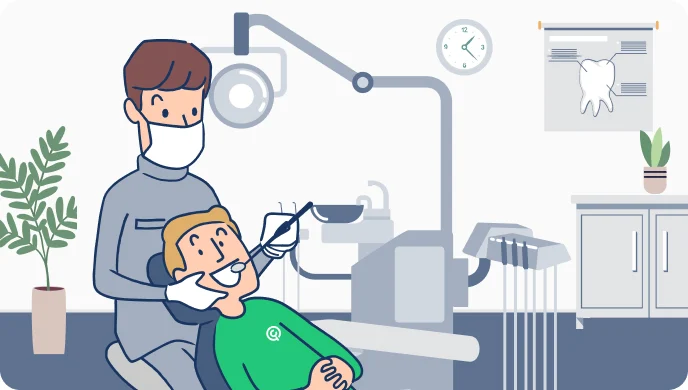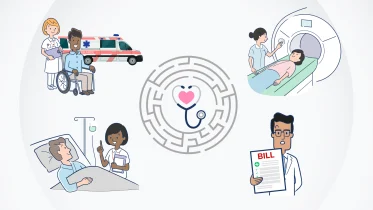Compare Dental Cover Across Australia
When it comes to dental health insurance, knowledge is power. It's why we've put together this guide from our team of experts to help you cut through the complexity and make a better choice when comparing cover.
It covers everything you need to know to compare health funds, and policies, with a focus on dental care.
Dental bills can quickly add up, especially if you need a crown or a root canal. Plus there's plenty of evidence linking poor oral health to other health conditions.
It's why many households take out dental cover, but you'll want to pick a policy that's right for you. After all, it's just as important to get value for what you're paying for, as well as saving cash.
Our experts have pulled together the data from our extensive knowledge of the health insurance, so you can make an informed decision about what level of dental health cover is right for you.
Key Points
Without dental cover, you could be out of pocket for thousands of dollars.
General dental covers the basics, like check-ups and cleaning
Major dental is for complex treatments like crowns and braces.
Waiting periods apply in most cases, usually up to 12 months for major dental.
Why Compare Dental Health Insurance?
Dental health insurance policies can vary greatly in terms of cost, coverage, and benefits. By comparing different policies, you can identify the one that offers the best value for your family’s needs and budget.
Whether you're looking for basic dental cover just for yourself, or a more comprehensive plan for your whole family, comparing options helps you find a policy that aligns with your oral health needs and financial circumstances.
COMPARE & SAVEWhat Are The Different Types of Dental Cover?
Dental cover falls under extras cover. Extras are services that typically aren't covered by Medicare or private hospital insurance, and don’t usually require hospital visits or extended stays in a ward. Dental treatments covered by private health insurance will fall into
General Dental
General dental covers the more preventative end of looking after your teeth.
Half-yearly check-ups, cleans, plaque removals, x-rays, and simple fillings & teeth whitening would all come under this area.
If you're a twenty something single with healthy teeth, you may be happy with basic check-ups and cleans.
Private Costs For General Dental Treatments
Treatment | Average Cost | Average Benefit | Average Gap |
|---|---|---|---|
Comprehensive oral exam | $62.40 | $48.06 | 12.33 |
Limited oral exam | $51.54 | $32.65 | $17.54 |
Clean (removal of plaque) | $64.90 | $43.57 | $15.44 |
Fissure Sealing (per tooth) | $57.20 | $37.26 | $19.36 |
Source: AIHW analysis of the General Treatment Dental data collection
Major Dental
Major dental covers the more serious and seriously expensive treatments. Root canals, crowns, and wisdom tooth removal all fall under major dental procedures. They're painful treatments at the best of times and they're seriously painful on your pocket.
If you're receiving government health care only, the public system isn't great at providing speedy treatment. For example, if you need a bridge, crown or to fix a chipped tooth, you could be waiting up to 12 months for public dental treatment in New South Wales*
Families and seniors often choose major dental as part of their health insurance, which includes other health services you’re likely to need. As you can see from the table below, major dental treatment can end up costing you thousands.
Private Costs For Major Dental Treatments
Treatment | Average Charge | Average Benefit | Average Gap |
|---|---|---|---|
Filling (1 -4 posterior surfaces) | 158.80 - 256.80 | $86.54 - $138.45 | $72.40 - $115.80 |
Filling (1 -3 anterior surfaces) | $150.85 - $203.20 | $76.72 - $111.36 | $73.72 - $96.95 |
Cusp capping/per cusp | $33.9 | $19.37 | $13.84 |
Pin retention | $35.94 | $17.50 | $17.03 |
Crowns | $1609.6 | $697.62 | $895.90 |
Source: AIHW analysis of the General Treatment Dental data collection
Orthodontic Treatments
Orthodontic treatments involve procedures to correct teeth and jaw alignment. They use devices like braces or clear aligners and can address issues like crooked teeth and various bite problems.
These treatments are crucial for oral health and aesthetics, as misaligned teeth can affect chewing, speech, oral hygiene, and your self-esteem.
Orthodontics cover varies across health funds, and their policies. It's usually included in extras cover or comprehensive dental plans. However, the extent of coverage, waiting periods, and lifetime limits can differ significantly.
When comparing health cover, it's important to review your policy details for orthodontics, understand your waiting periods, and check any limits on your coverage.
You can find our in depth guide on private health insurance for orthodontics here.
Private Costs For Orthodontic Treatments
Treatment | Description | Average Cost |
|---|---|---|
Traditional braces | Clear or metal brackets attached to the front of your teeth | $6000 - $9000 |
Lingual braces | Braces attached to the back of your teeth | $9500 - $15000 |
Clear aligners | Transparent, removable aligners to gradually shift teeth into their correct positions. | $6,500 – $9,500 |
Invisalign | Custom-fitted aligners work over your teeth for 22 hours a day | $3500 - $8500 |
Headgear | Usually worn by younger children to support jaw alignment | Varies depending on treatment |
Plates | Devices to fit over top and bottom of teeth to shift their position | Varies depending on treatment |
Palate expanders | Upper jaw device that fixes teeth crowding | Varies depending on treatment |
Waiting Periods for Dental Cover
Be cautious when planning to make near-future claims on your dental insurance. All health funds impose waiting periods for new extras cover. Typically, general dental claims require a few months of wait, while major dental and orthodontics can demand a year or more.
These extended waiting times help keep insurance premiums manageable, preventing immediate high-cost claims like root canals or braces. When considering dental insurance, anticipate your long-term needs. Below are some additional tips:
If you're already covered for dental extras, switching to a comparable yet cheaper policy allows you to retain your current waiting period status.
Once your waiting periods are fulfilled, there's potential for significant savings.
Regularly check for promotions as insurers occasionally waive or reduce waiting periods.
Understanding Waiting Periods for General Dental Services
When it comes to general dental services, such as oral exams, scale and cleans, simple fillings, fluoride treatments, X-rays, and simple tooth extractions, a standard waiting period of two months is typically applied. This means that once you've taken out your policy, you may need to wait for two months before you can claim these services on your health cover.
Waiting Periods for Major Dental, Endodontic, and Orthodontic Procedures
For more complex dental procedures, including tooth extraction, wisdom teeth removal, complex fillings, crowns and bridges, veneers, dentures, root canal therapy, periodontics, braces, and Invisalign, your waiting period is generally longer. You can expect to wait for about 12 months from the time you take out your policy before you can claim these services on your health insurance.
Waiting Periods for High-Cost Procedures
Waiting periods for certain high-cost procedures, such as orthodontics and braces, are usually 12 months but may have even longer, potentially stretching to 2 or 3 years. This is due to the significant costs associated with these treatments. It's important to note that orthodontic treatment is typically only included in higher levels of extras cover.
It's crucial to plan ahead when considering dental health insurance. By taking out cover well in advance, you can ensure you've served any necessary waiting periods by the time you need treatment. When comparing and purchasing extras health cover, make sure to confirm the applicable waiting periods and avoid unexpected out-of-pocket costs.
Please note that these are general estimates. Actual waiting periods may vary by insurance provider and specific policies. Our team of experts can help you find good value cover that takes care of your oral health needs.
General Dental | Major Dental | Orthodontics |
|---|---|---|
2 months | 12 months | 1-3 years |
Source: Waiting periods for private health insurance - Private Health Insurance Ombudsman
COMPARE & SAVEWhat Is the Child Dental Benefits Schedule?
The Child Dental Benefits Schedule (CDBS) is a government program providing up to $1,052 over two years for basic dental services for eligible children aged 2-17 years.
Eligibility requires the child to be a Medicare recipient, and your family to receive a relevant Australian government payment, such as Family Tax Benefit Part A.
The CDBS covers basic dental services but excludes orthodontic, cosmetic dental work, and hospital services.
When considering health cover options, it's important to understand the benefits of schemes like CDBS, its eligibility criteria, and the range of services it covers.
Key Aspect | Details |
|---|---|
Benefit Amount | Up to $1,052 over a two-calendar-year period |
Eligibility | Child must be aged between 2-17 years at any point in the calendar year, be eligible for Medicare, and receive a relevant Australian government payment (e.g., Family Tax Benefit Part A) |
Services Covered | Examinations, x-rays, cleaning, fissure sealing, fillings, root canals, extractions, and partial dentures |
Services Not Covered | Orthodontic, cosmetic dental work, or any services provided in a hospital |
Medicare Requirement | Yes, eligibility for Medicare is required |
Private Health Insurance Requirement | The scheme can be accessed whether a family has private health cover or not |
Benefit Cap Sharing | No, the benefit cap is per child and cannot be shared among family members |
Additional Benefits after Cap is Reached | No, once a child's benefit cap is reached within the two-year period, no further benefits are payable until a new cap becomes available in the next eligibility period. |
Dental Benefits By State
Public dental care in Australia varies significantly across states and territories, often limited and subject to long wait times. At Compare Club, we believe in empowering you with knowledge to make informed decisions about your dental health.
Understanding the landscape of public dental services is a crucial first step. Let's delve into the specifics of public dental care by state, highlighting the importance of comprehensive dental cover for your family.
State | Public Dental Care Services |
|---|---|
Australian Capital Territory (ACT) | - Services for children under 5, between 5 and 14 years, and young people under 18 with a Centrelink Pension Concession or Health Care Card. - Adult residents with a Centrelink issued Pension Concession or Health Care Card, a Veteran's affairs card, or an ACT Services Access card. |
New South Wales (NSW) | - Free dental care for all children under 18 years. - Adult residents eligible for Medicare and listed on a government concession card. |
Northern Territory (NT) | - Free public dental services for children under 18 years, individuals part of the Federal Government's Cleft Lip and Palate Scheme, holders of a Centrelink Pensioner Concession Card or a Centrelink Health Care Card, and remote residents needing emergency dental care. |
Queensland (QLD) | - Public oral health services for children aged four years or older and not completed Year 10, or eligible for the Medicare Child Dental Benefits Schedule, or listed as a dependent on a valid Centrelink concession card. - Adult residents eligible for Medicare and receiving benefits from a government concession card. |
South Australia (SA) | - Public dental care for individuals under 18 years through the School Dental Service clinic. - Adults with a current Health Care Card or Pensioner Concession Card. |
Tasmania (TAS) | - Government dental treatment for all children up to 18 years. - General dental care and denture services for adults with a current Pensioner Concession Card or Health Care Card. |
Victoria (VIC) | - Government dental services for children eligible for the Child Dental Benefits Schedule, or whose parents hold a Health Care Card or Pension Card, or who are youth justice clients in custodial care, or in out-of-home care. - Adults holding a Centrelink Health Care Card, Centrelink Pensioner Concession Card, Department of Veteran’s Affairs (DVA) Veteran Gold Card, Department of Veteran’s Affairs (DVA) Veteran Pensioner Concession Card, or who are refugee or asylum seekers, and Aboriginal and/or Torres Strait Islander people. |
Western Australia (WA) | - Dental care for children aged 0 to 4 whose name appears on their parent’s Health Care or Pension Concession Card, and students aged 5 to 16 or until the end of year 11, attending a Department of Education recognised school. - General and emergency dental care for individuals aged 17 and over who hold a current Health Care or Pension Concession Card, and residents living in remote locations without access to a private dentist. |
Average Dental Costs For A Dental Consult By State? Depending on where you live, average costs for dental treatments will vary. The table below provides a snapshot of the average costs, charges, and gaps for a periodic oral examination - a common dental check-up - across the different states and territories in Australia for the 2021-22 period.
These figures represent the median or 50th percentile, meaning half of the charges fall below these amounts and half are higher. Your 'gap' is the amount not covered by private health insurance, that you will need to pay for out of your own pocket.
Your costs will vary, depending on your age, the procedure you need, and any other individual costs for treatment set by your dental practice. It's always a good idea to ask for costs from your dentist before agreeing to any treatment.
State | Average Charge | Average Benefit | Average Gap |
|---|---|---|---|
NSW | $65 | $36.75 | $18.8 |
VIC | $57 | $38.5 | $18.35 |
QLD | $52 | $46 | $7.5 |
SA | $53 | $44 | $10.6 |
WA | $50 | $42.5 | $12.5 |
TAS | $65 | $49 | $10 |
ACT | $64 | $40.6 | $24.2 |
NT | $65 | $56 | $0 |
Australia | $55 | $40 | $13.9 |
Source: AIHW analysis of the General Treatment Dental data collection
Frequently Asked Questions About Dental Insurance
This section addresses common questions about dental health insurance, providing clear, concise answers to help you understand this complex topic better.
Does dental insurance cover dentures?
Yes, many dental insurance plans cover dentures under 'major dental', but the specifics and waiting periods vary. It's crucial to review your policy details to understand the extent of your cover.
When do dental annual benefit limits reset?
Dental benefit limits typically reset at the start of the calendar year, but this varies between providers. It's important to know when your benefits reset so you can maximise your health cover benefits.
Is emergency dental covered by Medicare?
Generally, Medicare in Australia does not cover emergency dental care, with some exceptions. For broader cover, you’ll want to consider private health insurance.
Does Medicare cover general dental costs?
Most general dental costs are not covered by Medicare in Australia, with some government programs offering limited benefits. Private health cover can provide more comprehensive dental benefits.
What is the difference between major & general dental?
General dental procedures include routine and simple treatments, while major dental procedures involve more complex treatments and surgeries.
What is the best health cover in Australia?
The "best" health insurance varies for each individual, and household. Comparing different policies based on your specific needs, budget, and lifestyle is the most effective way to find the best dental cover for you. Remember, the best policy is one that offers the cover you need at a price you can afford, for you and your family.
How much I claim back?
That depends on your policy. While 60% or 75% rebates are common, some funds offer up to 100%, often referred to as 'no gap'.
Do I need private health cover if I have a concession card?
If you're receiving a government benefit such as JobSeeker, Disability Support or the Age Pension, you'll already have access to free dental care through the public system.
Children are also covered under the Child Dental Benefits Schedule.
For a list of public clinics in your state, please see below.
Keep in mind waitlists can be quite long.
If you need emergency dental treatment for things like uncontrolled bleeding or swelling, you may be better off contacting your local dental clinic or hospital emergency department for free treatment.
* Compare Club compares selected products from a panel of trusted insurers. We do not compare all products in the market. This guide is opinion only and should not be taken as medical or financial advice. Check with a financial professional before making any decisions.





